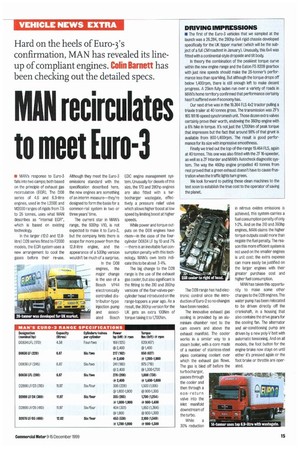VEHICLE NEWS EXTRA
Page 17

If you've noticed an error in this article please click here to report it so we can fix it.
Hard on the heels of Euro-3's
confirmation, MAN has revealed its lineup of compliant engines. Colin Barnett has
been checking out the detailed specs.
MAN minims to meet Euro-3
• MAN's response to Euro-3 falls into two camps; both based on the principle of exhaust gas recirculation (MR). The DOB series of 4.6 and 6.9-litre engines, used in the L2000 and M2000 ranges of rigids from 7.5 to 26 tonnes, uses what MAN describes as "internal EGR", which is based on existing technology.
In the larger (121) and 128litre) D28 series fitted to F2000 models, the EGA system uses a new arrangement to cool the gases before their re-use.
Although they meet the Euro-3 emissions standard with the specification described here, the new engines are something of an interim measure—they're designed to form the basis for a common-rail system in two or three years time.
The current star in MAN's range, the 600hp V10, is not expected to make it to Furo-3, but the company hints there is scope for more power from the 12.8-litre engine, and the appearance of a 530hp version wouldn't be much of a surprise.
In the 008 engines, the major change is the use of a Bosch VP44 electronically controlled distributor-type irdection pump and associ ated Bosch EDC engine management system. Unusually for diesels of this size, the 170 and 280hp engines are also fitted with a turbocharger wastegate, effectively a pressure relief valve which allows higher boost at low speed by limiting boost at higher speeds.
While power and torque outputs on the DOB engines have risen—in the case of the fourcylinder D0834 LF by 10 and 7% —there is an inevitable fuel consumption penalty with this technology. MAN's own tests indicate this to be about 3-4%.
The big change to the D28 range is the use of the exhaust gas cooler, but also significant is the fitting to the 310 and 360hp versions of the four-valves-percylinder head introduced on the range-toppers a year ago. As a result, the 360hp version for the UK gets an extra 100Nm of torque taking it to 1,700Nm. The D28 range has had electronic control since the introduction of Euro-2 so no changes have been needed.
The innovative exhaust gas cooling is provided by an aluminium chamber next to the cam covers and above the exhaust manifold. The cooler works in a similar way to a steam boiler, with a core made of a number of stainless-steel pipes containing coolant over which the exhaust gas flows. The gas is bled off before the turbocharger, passes through the cooler and then through a non-return valve into the inlet manifold downstream of the turbo.
While a 30% reduction in nitrous oxides emissions is achieved, this system carries a fuel consumption penalty of only 1-2%. And on the 310 and 360hp engines, MAN claims the higher torque outputs could more than negate the fuel penalty. The reason this more efficient system is not used on the smaller engines is unit cost: the extra expense can more easily be justified on the larger engines with their greater purchase cost and higher fuel consumption.
MAN has taken this opportunity to make some other changes to the D28 engines. The water pump has been relocated to be driven directly off the crankshaft, in a housing that also contains the drive gears for the cooling fan. The alternator and air-conditioning pump are driven by a new poly-V belt with automatic tensioning. And on all models, the foot button for the engine brake now stays on until either it's pressed again or the foot brake or throttle are operated.




































































































